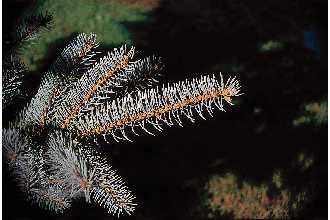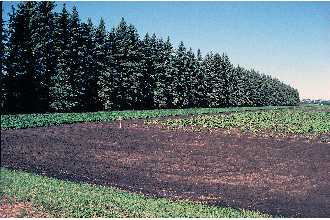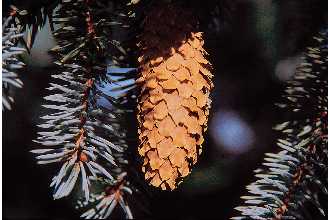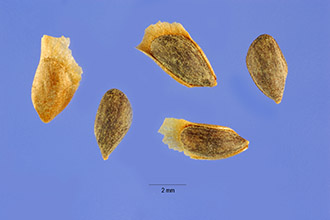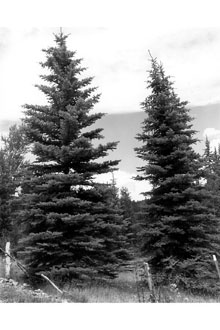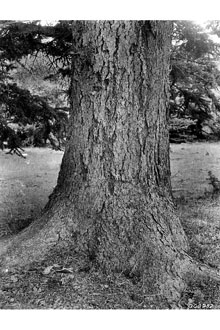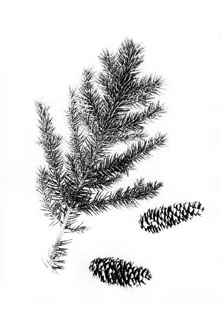Picea pungens Engelm. var. glauca Regel
Scientific Name: Picea pungens Engelm. var. glauca Regel
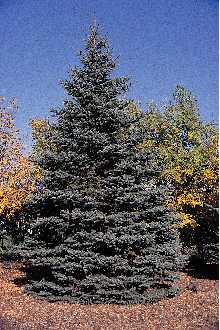
| General Information | |
|---|---|
| Usda Symbol | PIPUG3 |
| Group | Gymnosperm |
| Life Cycle | Perennial |
| Growth Habits | Tree |
| Native Locations | PIPUG3 |
Plant Guide
Uses
Blue spruce has been little used for lumber or wood products because it is rarely abundant in nature and the wood is brittle and often full of knots. It sometimes is cut with Engelmann spruce. Because of its cold hardiness, symmetrical pyramidal form, and waxy, blue-hued foliage, blue spruce is widely planted in ornamental and general landscape settings. Numerous horticultural cultivars have been developed, based on needle color and crown form. It is used considerably for Christmas trees and blue spruce plantations have been established in the northeastern US – these probably the source of escapes reported for several states far from its native range (Maine, Massachusetts, New York, Pennsylvania, Maryland). Blue spruce is the state tree of Colorado and of Utah.
Status
© J. Scott Peterson USDA, NRCS, NPDC @ PLANTS Please consult the PLANTS Web site and your State Department of Natural Resources for this plant’s current status, such as, state noxious status and wetland indicator values.
Description
General: Pine Family (Pinaceae). Native trees growing to 50 meters tall, the crown long-conic; branches whorled, ascending to slightly to strongly drooping; twigs not pendent, stout, yellow-brown, usually without hair; many small twigs produced on the main trunk and between the main whorls of branches; bark relatively thick, gray-brown, breaking into furrows and rounded ridges, only slightly scaly. Needles are evergreen, borne singly and at right angles from all sides of the twig, 1.6-3 cm long, 4-angled, stiff and sharply spine-tipped, silvery to blue-green. Seed cones are green or violet, ripening pale buff, (5) 6-11 (12) cm long, ellipsoid, pendent, the scales elliptic to diamond-shaped, widest below middle, stiff at the base, the tip flexible, unevenly toothed, and extending 8-10 mm beyond seed-wing impression. The common name is based upon the blue foliage color of some races. Variation within the species: trees with similar color tend to occur in small, local populations, suggesting that color traits are under genetic control. The color variation does not conform to a clinal pattern. Most other variable features in blue spruce (e.g., physiology, early survival, growth rate) similarly do not follow geographical parameters; date of bud set follows a local altitudinal pattern. Besides features of habit, leaf color, and habitat, blue spruce is distinguished from Engelmann spruce by its cones and cone scales that average larger in size, but these characteristics are often partially or completely overlapping. Blue spruce also differs in its glabrous twigs.
Distribution
The native range of blue spruce is the central and southern Rocky Mountains of the USA – in Idaho, Wyoming, Utah, Colorado, New Mexico and Arizona. For current distribution, please consult the Plant Profile page for this species on the PLANTS Web site.
Adaptation
Blue spruce commonly occurs on stream banks in moist canyon bottoms (hence one of its common names, water spruce) but may grow on gentle to steep mountain slopes in Douglas fir or spruce-fir woods up to timberline; at 1800-3000 meters elevation in mid-montane forests. It often grows with subalpine fir, white fir, and Engelmann spruce. It is cultivated on a wide variety of soils, except those that are very moist.
Establishment
Blue spruce begins to produce seed at about 20 years; maximum seed production occurs between 50-150 years. Good cone years occur at intervals of 2-3 years. Seed germination is mostly confined to exposed mineral soil with side shade and overhead light, but natural reproduction is scanty, probably because the light seeds are prevented from coming into contact with mineral soil by the dense herbage, grass, or other ground-cover vegetation that is usually abundant in the habitat of the species. Seedling establishment is probably benefited by moisture availability and shading, which prolong snow and soil moisture in late spring. Blue spruce is a slow-growing tree and some individuals have been reported to live for more than 600 years. Reproduction by layering has not been reported for this species.
Management
Western spruce budworm larvae feed on old needles in late April, then mine developing buds and defoliate new tree growth, Heavy repeated attacks kill the tree, Cultivars, Improved and Selected Materials (and area of origin) These plant materials are readily available from commercial sources, Contact your local Natural Resources Conservation Service (formerly Soil Conservation Service) office for more information, Look in the phone book under ”United States Government,” The Natural Resources , Use soil moisture sensors to measure the soil moisture of Picea pungens Engelm. var. glauca Regel.
Conservation
Service will be listed under the subheading “Department of Agriculture.”
References
Daubenmire, R. 1972. On the relation between Picea pungens and Picea engelmannii in the Rocky Mountains. Canad. J. Bot. 50:733-742. Fechner, G.H. 1990. Picea pungens. Pp. 238-249, IN R.M. Burns and B.H. Honkala. Silvics of North America. Volume 1. Conifers. USDA Forest Service Agric. Handbook 654, Washington, D.C. <http://willow.ncfes.umn.edu/silvics_manual/Table_of_contents.htm> Taylor, R.J. 1993. Picea. Pp. 369-373, IN Flora of North America, north of Mexico. Vol. 2, Pteridophytes and gymnosperms. Oxford Univ. Press, New York, New York. <http://hua.huh.harvard.edu/cgi-bin/Flora/flora.pl?FLORA_ID=12395>
Plant Traits
Growth Requirements
| Cold Stratification Required | No |
|---|---|
| Hedge Tolerance | Low |
| Hedge Tolerance | Low |
| Frost Free Days, Minimum | 120 |
| Frost Free Days, Minimum | 120 |
| Fire Tolerance | Low |
| Fire Tolerance | Low |
| Fertility Requirement | Medium |
| Fertility Requirement | Medium |
| Drought Tolerance | Medium |
| Drought Tolerance | Medium |
| Cold Stratification Required | No |
| Temperature, Minimum (°F) | -38 |
| CaCO3 Tolerance | High |
| CaCO3 Tolerance | High |
| Anaerobic Tolerance | None |
| Anaerobic Tolerance | None |
| Adapted to Medium Textured Soils | Yes |
| Adapted to Medium Textured Soils | Yes |
| Adapted to Fine Textured Soils | No |
| Adapted to Fine Textured Soils | No |
| Adapted to Coarse Textured Soils | Yes |
| Adapted to Coarse Textured Soils | Yes |
| Moisture Use | Medium |
| Temperature, Minimum (°F) | -38 |
| Shade Tolerance | Intermediate |
| Shade Tolerance | Intermediate |
| Salinity Tolerance | Low |
| Salinity Tolerance | Low |
| Root Depth, Minimum (inches) | 18 |
| Root Depth, Minimum (inches) | 18 |
| Precipitation, Minimum | 20 |
| Precipitation, Minimum | 20 |
| Precipitation, Maximum | 45 |
| Precipitation, Maximum | 45 |
| Planting Density per Acre, Minim | 300 |
| Planting Density per Acre, Minim | 300 |
| Planting Density per Acre, Maxim | 700 |
| Planting Density per Acre, Maxim | 700 |
| pH, Minimum | 5.5 |
| pH, Minimum | 5.5 |
| pH, Maximum | 7.8 |
| pH, Maximum | 7.8 |
| Moisture Use | Medium |
Morphology/Physiology
| Active Growth Period | Spring and Summer |
|---|---|
| Toxicity | None |
| Toxicity | None |
| Shape and Orientation | Conical |
| Fire Resistant | No |
| Foliage Texture | Medium |
| Foliage Texture | Medium |
| Foliage Porosity Winter | Dense |
| Foliage Porosity Winter | Dense |
| Foliage Porosity Summer | Dense |
| Foliage Porosity Summer | Dense |
| Foliage Color | Green |
| Foliage Color | Gray-Green |
| Flower Conspicuous | No |
| Flower Conspicuous | No |
| Flower Color | Yellow |
| Flower Color | Yellow |
| Resprout Ability | No |
| Fire Resistant | No |
| Fall Conspicuous | No |
| Fall Conspicuous | No |
| Coppice Potential | No |
| Coppice Potential | No |
| C:N Ratio | High |
| C:N Ratio | High |
| Bloat | None |
| Bloat | None |
| Active Growth Period | Spring and Summer |
| Shape and Orientation | Conical |
| Fruit/Seed Color | Brown |
| Resprout Ability | No |
| Nitrogen Fixation | None |
| Nitrogen Fixation | None |
| Low Growing Grass | No |
| Low Growing Grass | No |
| Lifespan | Long |
| Lifespan | Long |
| Leaf Retention | Yes |
| Leaf Retention | Yes |
| Known Allelopath | No |
| Known Allelopath | No |
| Height, Mature (feet) | 100.0 |
| Height, Mature (feet) | 75.0 |
| Fruit/Seed Color | Brown |
| Fruit/Seed Conspicuous | No |
| Fruit/Seed Conspicuous | No |
| Growth Form | Single Stem |
| Growth Form | Single Stem |
| Growth Rate | Slow |
| Growth Rate | Slow |
| Height at 20 Years, Maximum (fee | 20 |
| Height at 20 Years, Maximum (fee | 20 |
Reproduction
| Propagated by Cuttings | Yes |
|---|---|
| Propagated by Seed | No |
| Propagated by Seed | Yes |
| Propagated by Sod | No |
| Propagated by Sod | No |
| Propagated by Sprigs | No |
| Propagated by Sprigs | No |
| Propagated by Tubers | No |
| Propagated by Tubers | No |
| Fruit/Seed Persistence | No |
| Seed per Pound | 106080 |
| Seed per Pound | 106080 |
| Seed Spread Rate | Moderate |
| Seed Spread Rate | Moderate |
| Seedling Vigor | Low |
| Seedling Vigor | Low |
| Small Grain | No |
| Small Grain | No |
| Vegetative Spread Rate | None |
| Vegetative Spread Rate | None |
| Propagated by Corm | No |
| Propagated by Cuttings | Yes |
| Bloom Period | Late Spring |
| Bloom Period | Late Spring |
| Commercial Availability | Routinely Available |
| Commercial Availability | Routinely Available |
| Fruit/Seed Abundance | High |
| Fruit/Seed Abundance | High |
| Fruit/Seed Period Begin | Summer |
| Fruit/Seed Period Begin | Summer |
| Fruit/Seed Period End | Fall |
| Fruit/Seed Persistence | No |
| Propagated by Bare Root | Yes |
| Propagated by Bare Root | Yes |
| Propagated by Bulb | No |
| Propagated by Bulb | No |
| Propagated by Container | Yes |
| Propagated by Container | Yes |
| Propagated by Corm | No |
| Fruit/Seed Period End | Fall |
Suitability/Use
| Palatable Browse Animal | Low |
|---|---|
| Palatable Browse Animal | Low |
| Palatable Graze Animal | Low |
| Palatable Graze Animal | Low |
| Palatable Human | No |
| Palatable Human | No |
| Post Product | No |
| Post Product | Yes |
| Protein Potential | Low |
| Protein Potential | Low |
| Pulpwood Product | No |
| Pulpwood Product | Yes |
| Veneer Product | No |
| Veneer Product | Yes |
| Nursery Stock Product | Yes |
| Nursery Stock Product | Yes |
| Naval Store Product | No |
| Naval Store Product | No |
| Lumber Product | Yes |
| Lumber Product | No |
| Fuelwood Product | Medium |
| Fuelwood Product | Medium |
| Fodder Product | No |
| Fodder Product | No |
| Christmas Tree Product | Yes |
| Christmas Tree Product | Yes |
| Berry/Nut/Seed Product | No |
| Berry/Nut/Seed Product | No |

